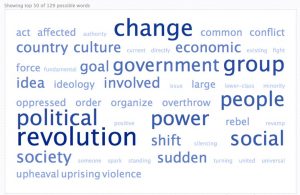August 28, 2019
Today, we started off class by watching the music video, Beautiful, by Snoop Dogg ft. Pharrell. The music video took place in Brazil. It demonstrated the diversity of people, mainly women, in Brazil. Not only did the music highlight the diversity of people, it also showed many public spaces in Brazil. After the video, Tristan presented his Latin America in the News. He talked about the return of an Incan mummy to Native Bolivia. During his presentation he commented on the absurdity that once the indeginous body was no longer useful, since societal change on display to the public changed, only then was the body returned to its native land.
Historical Skills and Questions for Consideration
- How to read and analyze secondary sources.
- What is Becker’s main argument?
- What tools does Becker’s text contain to orient our study?
- How do the scholarly definition of revolution we’ve encountered so far with with your ideas?
Key Terms
Anarchism: opposes hierarchies as unnecessary and fundamentally harmful to the realization of a more just and equal society. Anarchists fought to destroy existing institutions, eliminate governments and capitalism, and create a new society. Can be extreme individualism to complete collectivism.
Marxism: Karl Marx and Friedrich Engles ideas for the struggle of the working class to attain a higher form of human society. They critiqued capitalism and believed the industrial working class were the agent of social change.
Imperialism: a policy of extending a country’s power and influence through diplomacy or military force.
Anti-Colonial: Tupac Amaru, Haitian Slave Revolt, and Cancudos were all anti colonial revolts against Spain and Portugal in order to gain independence.
Transcribe Passage: Define revolutions in your own words:

Becker laid out the groundwork to multiple revolutions and his purpose was to connect past revolutions to now. The class defines revolution as change, political, power, group, and social. As we read in chapter one, all of the anti-colonial revolts’ end game was to create change. In all the revolutions there was a power struggle and social struggle. The way we define revolutions now correlates greatly to what revolutions meant in the past. During our discussion, questions arose as to why race and oppression were not one of the words we, as a class, associated with revolutions. The last question was, are revolutions always violent? Majority of the class voted for “no, not always” instead of “yes”.
Links
- Racial Diversity in Brazil “turns a new page”: https://www.ft.com/content/abe60816-3cc9-11e8-bcc8-cebcb81f1f90
- Overall Impacts of Imperialism: https://latinamerica1800s.weebly.com/overall-impacts-of-imperialism.html
- The Inca Ruler and Peruvian Revolutionary Who Inspired 2Pac’s Persona: https://culturacolectiva.com/history/tupac-amaru-ii-peruvian-revolutionary-tupac-shakur-rapper
Examination Questions
- What makes a revolution violent? Can all revolutions be non-violent? If not, what makes some revolutions violent and other non-violent?
- How much power do music videos have on the perception of a country? (e.g. the Beautiful music video by Snoop Dogg ft. Pharrell showcased the country of Brazil)
- Does the definition of revolution vary across different identities? If so, why? (e.g socio-economic status, gender, sexuality, religious affiliation, race, etc)
